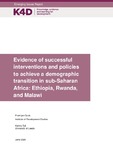Evidence of Successful Interventions and Policies to Achieve a Demographic Transition in sub-Saharan Africa: Ethiopia, Rwanda, and Malawi
Abstract
This literature review is part of the DFID–K4D Learning Journey on Supporting a Demographic Transition in Sub-Saharan Africa. The review’s focus is on the available evidence that can explain the success of new champion countries in sub-Saharan Africa on spurring the demographic transition. This literature review concludes that: (i) Intersectoral approaches (e.g. integrating family planning programmes with education, health, and economic programmes) and approaches that are embedded and strengthened through legislation (e.g. revision of abortion laws, and child marriage laws) are particularly important to support the demographic transition in sub-Saharan Africa; (ii) The demographic transition can be initiated before achieving economic growth. Although most African countries are in the phase of a demographic transition, only some have measured a significant decline in fertility rates. Research is clear that the onset of the fertility decline is not only late in sub-Saharan Africa compared with other developing regions, but that the pace in which this happens is slower than expected. Evidence shows that the desire for children has been, and remains, much more pronounced in sub-Saharan Africa than elsewhere. Although the desire for more children is higher in sub-Saharan Africa, both women and men have consistently reported that their ideal family size is smaller than the national total fertility rate. Often couples have more children than they want, which shows the need for upgraded family planning services. Ethiopia, Rwanda, and Malawi are used as case studies because these countries’ rate of transition has accelerated more than in other parts of Africa recently. This report will appraise the extent to which the objectives of their population and family planning policies have been realised. Data is taken from national/country-level and international sources (the United Nations World Population Policies Database, the World Bank’s World Development Indicators, and the Population Council), policy documents, research findings, as well as development plan and programme reports.
Citation
Quak, E. & Tull, K. (2020). Evidence of successful interventions and policies to achieve a demographic transition in sub-Saharan Africa: Ethiopia, Rwanda, and Malawi. K4D Emerging Issues Report No.30, Brighton, UK: Institute of Development Studies.Is part of series
K4D Emerging Issues Report;30Rights holder
© DFID - Crown copyright 2020Collections
- K4D [937]

